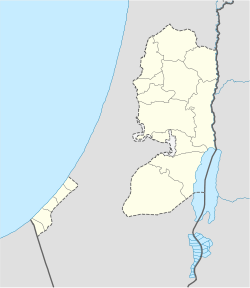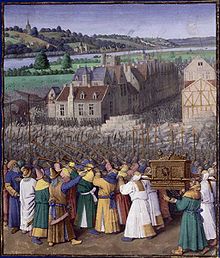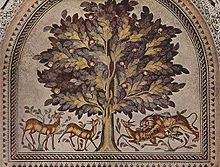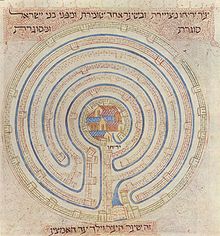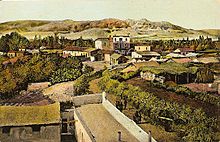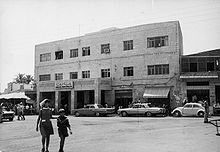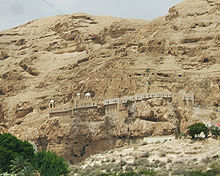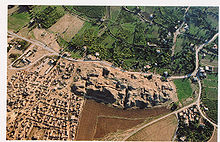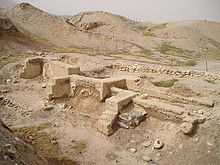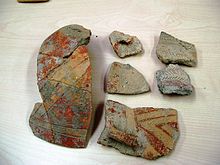- Jericho
-
Jericho Other transcription(s) – Arabic أريحا – Also spelled Ariha (official) – Hebrew יְרִיחוֹ Jericho from the south 
Municipal Seal of JerichoLocation of Jericho within the Palestinian territories Coordinates: 31°51′19.60″N 35°27′43.85″E / 31.855444°N 35.4621806°ECoordinates: 31°51′19.60″N 35°27′43.85″E / 31.855444°N 35.4621806°E Governorate Jericho Founded 9000 BCE Government – Type City (from 1994) – Head of Municipality Hassan Saleh[1] Population (2006) – Jurisdiction 20,400 Name meaning "Fragrant" Website www.jericho-city.org Jericho (
 /ˈdʒɛrɪkoʊ/; Arabic: أريحا Ārīḥā [ʔæˈriːħɑː] (
/ˈdʒɛrɪkoʊ/; Arabic: أريحا Ārīḥā [ʔæˈriːħɑː] ( listen)); Hebrew: יְרִיחוֹ Yəriḥo [jeʁiˈħo] (
listen)); Hebrew: יְרִיחוֹ Yəriḥo [jeʁiˈħo] ( listen) is a city located near the Jordan River in the West Bank of the Palestinian territories. It is the capital of the Jericho Governorate and has a population of more than 20,000.[2] Situated well below sea level on an east-west route 16 kilometres (10 mi) north of the Dead Sea, Jericho is the lowest permanently inhabited site on earth. It is also believed to be the oldest continuously inhabited city in the world.[3][4][5]
listen) is a city located near the Jordan River in the West Bank of the Palestinian territories. It is the capital of the Jericho Governorate and has a population of more than 20,000.[2] Situated well below sea level on an east-west route 16 kilometres (10 mi) north of the Dead Sea, Jericho is the lowest permanently inhabited site on earth. It is also believed to be the oldest continuously inhabited city in the world.[3][4][5]Described in the Old Testament as the "City of Palm Trees", copious springs in and around Jericho have made it an attractive site for human habitation for thousands of years.[6] It is known in Judeo-Christian tradition as the place of the Israelites' return from bondage in Egypt, led by Joshua, the successor to Moses. Archaeologists have unearthed the remains of more than 20 successive settlements in Jericho, the first of which dates back 11,000 years (9000 BCE),[7] almost to the very beginning of the Holocene epoch of the Earth's history.
Contents
Etymology
Jericho's Arabic name, Ārīḥā, means "fragrant" and derives from the Canaanite word Reah, of the same meaning.[8][9][10][11] Jericho's name in Hebrew, Yəriḥo, is also thought to derive from that root, though an alternative theory holds that it is derived from the word meaning "moon" (Yareah) in Canaanite, since the city was an early centre of worship for lunar deities.[12]
History
Ancient times
Natufian Hunter-Gatherers c. 10,000 BCE
Jericho is one of the oldest continuously inhabited cities in the world, with evidence of settlement dating back to 9000 BCE. During the Younger Dryas period of cold and drought, permanent habitation of any one location was not possible. However, the spring at what would become Jericho was a popular camping ground for Natufian hunter-gatherer groups, who left a scattering of crescent microlith tools behind them.[13] Around 9600 the droughts and cold of the Younger Dryas Stadial had come to an end, making it possible for Natufian groups to extend the duration of their stay, eventually leading to year round habitation and permanent settlement.
Pre-Pottery Neolithic A, c. 9600 BCE
The first permanent settlement was built near the Ein as-Sultan spring between 10000 and 9000 BCE. As the world warmed, a new culture based on agriculture and sedentary dwelling emerged, which archaeologists have termed "Pre-Pottery Neolithic A" (abbreviated as PPNA). PPNA villages are characterized by small circular dwellings, burials of the dead within the floors of buildings, reliance on hunting wild game, the cultivation of wild or domestic cereals, and no use of pottery. At Jericho, circular dwellings were built of clay and straw bricks left to dry in the sun, which were plastered together with a mud mortar. Each house measured about 5 metres across, and was roofed with mud-smeared brush. Hearths were located within and outside the homes.[14]
By about 9400 BCE the town had grown to more than 70 dwellings, and was home to over 1000 people. The most striking aspect of this early town was a massive stone wall over 3.6 metres high, and 1.8 metres wide at the base. Inside this wall was a tower over 3.6 metres high, contained an internal staircase with 22 stone steps.[15][9] The wall and tower were unprecedented in human history, and would have taken a hundred men more than a hundred days to construct it. The use of this wall and tower was likely for defence against flood water and mud flows from the nearby Jordan river.
Later occupation
After a few centuries it was abandoned for a second settlement, established in 6800 BCE, perhaps by an invading people who absorbed the original inhabitants into their dominant culture. Artifacts dating from this period include ten skulls, plastered and painted so as to reconstitute the individuals' features.[9] These represent the first example of portraiture in art history, and it is thought that they were kept in people's homes while the bodies were buried.[5][16] This was followed by a succession of settlements from 4500 BCE onward, the largest being constructed in 2600 BCE.[9]
Archaeological evidence indicates that in the latter half of the Middle Bronze Age (circa 1700 BCE) the city enjoyed some prosperity, its walls having been strengthened and expanded.[17] According to carbon dating the Canaanite city (Jericho City IV) was destroyed between 1617 and 1530, but rounded as c.1550.[18] The site remained uninhabited until the city was refounded in the 9th century BCE.[citation needed]
In the 8th century BCE the Assyrians invaded from the north, followed by the Babylonians, and Jericho was depopulated between 586 and 538 BCE, the period of the Jewish exile to Babylon. Cyrus the Great, the Persian king, refounded the city one mile southeast of its historic site at the mound of Tell es-Sultan and returned the Jewish exiles after conquering Babylon in 539 BCE.[9]
Classical antiquity
Jericho went from being an administrative centre under Persian rule to serving as the private estate of Alexander the Great between 336 and 323 BCE after his conquest of the region. In the middle of the 2nd century BCE Jericho was under Hellenistic rule, and the Syrian General Bacchides built a number of forts to strengthen the defences of the area around Jericho against invasion by the Macabees (1 Macc 9:50). One of these forts, built at the entrance to Wadi Qelt, was later refortified by Herod the Great, who named it Kypros after his mother.[19]
Herod originally leased Jericho from Cleopatra after Mark Antony gave it to her as a gift. After their joint suicide in 30 BCE Octavian assumed control of the Roman Empire and granted Herod free rein over Jericho. Herod’s rule oversaw the construction of a hippodrome-theatre (Tel es-Samrat) to entertain his guests and new aqueducts to irrigate the area below the cliffs and reach his winter palace built at the site of Tulul al-Alaiq.[19]
The dramatic murder of Aristobulus III in a swimming pool in Jericho, as told by the Roman Jewish historian Josephus, took place during a banquet organized by Herod's Hasmonean mother-in-law. After the construction of its palaces the city had functioned not only as an agricultural center and as a crossroad but as a winter resort for Jerusalem's aristocracy.[20]
Herod was succeeded by his son, Archelus, who built an adjacent village in his name, Archelais, to house workers for his date plantation (Khirbet al-Beiyudat). First-century Jericho is described in Strabo's Geography as follows:
Jericho is a plain surrounded by a kind of mountainous country, which in a way, slopes toward it like a theatre. Here is the Phoenicon, which is mixed also with all kinds of cultivated and fruitful trees, though it consists mostly of palm trees. It is 100 stadia in length and is everywhere watered with streams. Here also are the Palace and the Balsam Park."[19]The rock-cut tombs of a Herodian and Hasmonean era cemetery lie in the lowest part of the cliffs between Nuseib al-Aweishireh and Jebel Quruntul in Jericho and were used between 100 BCE and 68 CE.[19]
The Christian Gospels state that Jesus passed through Jericho where he healed one[21][22] or two[23] blind beggars and inspired a local chief tax-collector named Zacchaeus to repent of his dishonest practices. The road between Jerusalem and Jericho is the setting for the Parable of the Good Samaritan[24]
After the fall of Jerusalem to Vespasian's armies in 70 CE, Jericho declined rapidly, and by 100 CE it was but a small Roman garrison town.[25] A fort was built there in 130 and played a role in putting down the Bar Kochba revolt in 133. Accounts of Jericho by a Christian pilgrim are given in 333. Shortly thereafter the built-up area of the town was abandoned and a Byzantine Jericho, Ericha, was built a mile (1 1⁄2 km) to the east, around which the modern town is centred.[25] Christianity took hold in the city during the Byzantine era and the area was heavily populated. A number of monasteries and churches were built, including St George of Koziba in 340 CE and a domed church dedicated to Saint Eliseus.[20] At least two synagogues were also built in the 6th century CE.[19] The monasteries were abandoned after the Persian invasion of 614.[9]
Arab caliphate period
Jericho, by now "Ariha", fell under the province (jund) "al-Filastin". The Arab Muslim historian Musa b. 'Uqba (d. 141 / 758) recorded that caliph 'Umar exiled the Jews and Christians of Khaybar into Jericho (and Tayma).[26]
By 659 that province had come under the control of Mu'awiya, founder of the Umayyads as a dynasty. That year, an earthquake struck Jericho and destroyed nearly all of it.[27] A decade later the pilgrim Arculf visited Jericho and found it a ruin, all its "miserable Canaanite" inhabitants now dispersed in shantytowns around the Dead Sea shore.[28]
The tenth caliph of that dynasty, Hisham ibn Abd al-Malik, built a palatial complex known as Khirbet al-Mafjar about one mile north of Tell as-Sultan in 743, and two mosques, a courtyard, mosaics, and other items from it can still be seen in situ today, despite its having been partially destroyed in an earthquake in 747.
Umayyad rule ended in 750 and was followed by the Arab caliphates of the Abbasid and Fatimid dynasties. Irrigated agriculture was developed under Islamic rule, reaffirming Jericho's reputation as a fertile "City of the Palms".[29] Al-Maqdisi, the Arab geographer, wrote in 985 that, "the water of Jericho is held to be the highest and best in all Islam. Bananas are plentiful, also dates and flowers of fragrant odor."[30] Jericho is also referred to by him as one of the principal cities of Jund Filastin.[31]
The city flourished until 1071 and the invasion of the Seljuk Turks, followed by the upheavals of the Crusades. In 1179, the Crusaders rebuilt the Monastery of St. George of Koziba, at its original site six miles from the center of town. They also built another two churches and a monastery dedicated to John the Baptist, and are credited with introducing sugarcane production to the city.[32] In 1187, the Crusaders were evicted by the Ayyubid forces of Saladin after their victory in the Battle of Hattin, and the town slowly went into decline.[9]
In 1226, Arab geographer Yaqut al-Hamawi said of Jericho, "it has many palm trees, also sugarcane in quantities, and bananas. The best of all the sugar in the Ghaur land is made here." In the 14th century, Abu al-Fida writes there are sulfur mines in Jericho, "the only ones in Palestine."[33]
Ottoman period (1517–1918)
In the late years of Ottoman rule, Jericho formed part of the waqf and imerat of Jerusalem. The villagers processed indigo as one source of revenue, using a cauldron specifically for this purpose that was loaned to them by the Ottoman authorities in Jerusalem.[34] For most of the Ottoman period, Jericho was a small village of farmers susceptible to attacks by Bedouins. The French traveler Laurent d'Arvieux described the city in 1659 as "now desolate, and consists only of about fifty poor houses, in bad condition... The plain around is extremely fertile; the soil is middling fat; but it is watered by several rivulets, which flow into the Jordan. Notwithstanding these advantages. only the gardens adjacent to the town are cultivated."[35] In the 19th century, European scholars, archaeologists and missionaries visited often. The first excavation at Tell as-Sultan was carried out in 1867, and the monasteries of St. George of Koziba and John the Baptist were refounded and completed in 1901 and 1904, respectively.[9]
20th century
After the collapse of the Ottoman empire at the end of World War I, Jericho came under the rule of the British Mandate. The British built fortresses in Jericho during World War II with the help of the Jewish company Solel Boneh, and bridges were rigged with explosives in preparation for a possible invasion by German allied forces.[36]
Jericho was captured by the Hashemite Kingdom of Jordan during the 1948 Arab-Israeli war. The Jericho Conference, organized by King Abdullah and attended by over 2,000 Palestinian delegates in 1948 proclaimed "His Majesty Abdullah as King of all Palestine" and called for "the unification of Palestine and Transjordan as a step toward full Arab unity." In mid-1950, Jordan formally annexed the West Bank and Jericho residents, like other residents of West Bank localities became Jordanian citizens.[37]
Jericho was captured by Israel during the Six-Day War of 1967 along with the rest of the West Bank. It was one of the first cities handed over to Palestinian Authority control in 1994, in accordance with the Oslo accords. In 1994, Israel and the Palestinians signed a sweeping agreement laying the foundations for economic relations between Israel, Jericho and other cities under Palestinian self-rule.[38]
21st century
In 2001, during the Second Intifada, Jericho was retaken by Israel. On 14 March 2006, the Israel Defense Forces launched Operation Bringing Home the Goods, in which it took captive six inmates from a Jericho prison following a 10-hour siege. Israel's reason for the siege was to capture PFLP general secretary, Ahmad Sa'adat and five other inmates for the assassination of Israeli tourist minister Rehavam Zeevi. At least two people were killed and 35 wounded in the incident. Before the siege, British and American monitors were guarding the prison but withdrew, citing lax security arrangements. The siege caused an uproar amongst the PFLP members and supporters as well as other PLO factions, and as a result Palestinian militants raided and kidnapped British and European citizens in the West Bank and Gaza Strip.[39]
After Hamas assaulted a neighborhood in Gaza mostly populated by the Fatah-aligned Hilles clan in response to their attack on Hamas which killed six of its members, the Hilles clan was relocated to Jericho on 4 August 2008.[40]
Geography
Jericho is located 258 metres (846 ft) below sea level in an oasis in Wadi Qelt in the Jordan Valley.[4][9][41] The nearby spring of Ein es-Sultan produces 1,000 gallons of water per minute (3.8 m3/min), irrigating some 2,500 acres (10 km2) through multiple channels and feeding into the Jordan River, 6 miles (10 km) away.[9][41] Annual rainfall is 6.4 inches (160 mm), mostly concentrated between November and February. The average temperature is 59 °F (15 °C) in January and 88 °F (31 °C) in August. The constant sunshine, rich alluvial soil, and abundant water from the spring have always made Jericho an attractive place for settlement.[41]
Archaeology
The first excavations of the site were made by Charles Warren in 1868. Ernst Sellin and Carl Watzinger excavated Tell es-Sultan and Tulul Abu el-'Alayiq between 1907–1909 and in 1911, and John Garstang excavated between 1930 and 1936. Extensive investigations using more modern techniques were made by Kathleen Kenyon between 1952 and 1958. Lorenzo Nigro and Nicolo Marchetti conducted a limited excavation in 1997.
Tell es-Sultan
The earliest settlement was located at the present-day Tell es-Sultan (or Sultan's Hill), a couple of kilometers from the current city. In Arabic and in Hebrew, tell means "mound" -- consecutive layers of habitation built up a mound over time, as is common for ancient settlements in the Middle East and Anatolia. Jericho is the type site for the Pre-Pottery Neolithic A (PPN A) and B periods.
Stone Age
Epipaleolithic—construction at the site appears to predate the invention of agriculture, with the construction of Natufian culture structures beginning earlier than 9000 BCE, the very beginning of the Holocene epoch in geologic history.[5]
Pre-Pottery Neolithic A (8350–7370 BCE); sometimes it is called Sultanian. The site is a 40,000 square metre settlement surrounded by the Wall of Jericho, with the Tower of Jericho in the centre of one wall. Along with Tell Qaramel, this is one of the first walls ever to be discovered, thus suggesting some kind of social organization. The town contained round mud-brick houses, yet no street planning.[42] The identity and number of the inhabitants (some sources say 2000–3000 dwellers)[7] of Jericho during the PPN A period is still under debate, though it is known that they had domesticated emmer wheat, barley and pulses and hunted wild animals.
Pre-Pottery Neolithic B, 7220 BCE to 5850 BCE (but carbon-14-dates are few and early). Expanded range of domesticated plants. Possible domestication of sheep. Apparent cult involving the preservation of human skulls, with facial features reconstructed from plaster and eyes set with shells in some cases.
After the PPN A settlement-phase there was a settlement hiatus of several centuries, then the PPN B settlement was founded on the eroded surface of the tell. The architecture consisted of rectilinear buildings made of mudbricks on stone foundations. The mudbricks were loaf-shaped with deep thumb prints to facilitate bounding. No building has been excavated in its entirety. Normally, several rooms cluster around a central courtyard. There is one big room (6.5 × 4 m (21.33 ft × 13.12 ft) and 7 × 3 m (22.97 ft × 9.84 ft)) with internal divisions, the rest are small, presumably used for storage. The rooms have red or pinkish terrazzo-floors made of lime. Some impressions of mats made of reeds or rushes have been preserved. The courtyards have clay floors.
Kathleen Kenyon interpreted one building as a shrine. It contained a niche in the wall. A chipped pillar of volcanic stone that was found nearby might have fit into this niche.
The dead were buried under the floors or in the rubble fill of abandoned buildings. There are several collective burials. Not all the skeletons are completely articulated, which may point to a time of exposure before burial. A skull cache contained seven skulls. The jaws were removed and the faces covered with plaster; cowries were used as eyes. A total of ten skulls were found. Modelled skulls were found in Tell Ramad and Beisamoun as well.
Other finds included flints, such as arrowheads (tanged or side-notched), finely denticulated sickle-blades, burins, scrapers, a few tranchet axes, obsidian, and green obsidian from an unknown source. There were also querns, hammerstones, and a few ground-stone axes made of greenstone. Other items discovered included dishes and bowls carved from soft limestone, spindle whorls made of stone and possible loom weights, spatulae and drills, stylised anthropomorphic plaster figures, almost life-size, anthropomorphic and theriomorphic clay figurines, as well as shell and malachite beads.
In the late 4th millennium BCE, Jericho was occupied during Neolithic 2 and the general character of the remains on the site link it culturally with Neolithic 2 sites in the West Syrian and Middle Euphrates groups. This link is established by the presence of rectilinear mud-brick buildings and plaster floors that are characteristic of the age.
Bronze Age
During the Middle Bronze Age Jericho was a small prominent city of the Canaan region, reaching its greatest Bronze Age extent in the period from 1700 to 1550 BCE. It seems to have reflected the greater urbanization in the area at that time, and has been linked to the rise of the Maryannu, a class of chariot-using aristocrats linked to the rise of the Mitannite state to the north. Kathleen Kenyon reported “...the Middle Bronze Age is perhaps the most prosperous in the whole history of Kna'an. ... The defenses ... belong to a fairly advanced date in that period” and there was “a massive stone revetment... part of a complex system” of defenses (pp. 213–218).[43] Bronze-age Jericho fell in the 16th century at the end of the Middle Bronze Age, the calibrated carbon remains from its City-IV destruction layer dating to 1617–1530 BCE. Notably this carbon dating c. 1573 BCE confirmed the accuracy of the stratigraphical dating c. 1550 by Kenyon.
Synagogues
For more details on this topic, see Shalom Al Yisrael Synagogue.The Jericho Synagogue in the Royal Maccabean winter palace at Jericho dates from 70-50 BCE.
A synagogue dating to the late 6th or early 7th century CE was discovered in Jericho in 1936, and was named Shalom Al Israel, or "peace unto Israel", after the central Hebrew motto in its mosaic floor. It was controlled by Israel after the Six Day War, but after the handover to Palestinian Authority control per the Oslo Accords, it has been a source of conflict. On the night of October 12, 2000, the synagogue was vandalized by Palestinians who burned holy books and relics and damaged the mosaic.[44][45]
The Na'aran synagogue, another Byzantine era construction, was discovered on the northern outskirts of Jericho in 1918. While less is known of it than Shalom Al Israel, it has a larger mosaic and is in similar condition.[46]
Demographics
Demographics have varied widely depending on the dominant ethnic group and rule in the region over the past three thousand years. In a 1945 land and population survey by Sami Hadawi, 3,010 inhabitants is the figure given for Jericho, of which 94% (2840) were Arab and 6% (170) were Jews.[47]
In the first census carried out by the Palestinian Central Bureau of Statistics (PCBS), in 1997, Jericho's population was 14,674. Palestinian refugees constituted a significant 43.6% of the residents or 6,393 people.[48] The gender make-up of the city was 51% male and 49% female. Jericho has a young population, with nearly half (49.2%) of the inhabitants being under the age of 20. People between the ages of 20 and 44 made up 36.2% of the population, 10.7% between the ages of 45 and 64, and 3.6% were over the age of 64.[49]
Based on PCBS projections, Jericho presently has an Arab Palestinian population of over 20,000.[2] The current mayor is Hassan Saleh, a former lawyer.
Health care
In April 2010, the United States Agency for International Development (USAID) held a groundbreaking ceremony for the renovation of the Jericho Governmental Hospital. USAID is providing $2.5 million in funding for this project.[50]
Twin towns - Sister cities
See also: List of twin towns and sister cities in PalestineJericho is twinned with:
 Campinas in Brazil
Campinas in Brazil Pisa in Italy (since 2000)[51]
Pisa in Italy (since 2000)[51] Lyon in France
Lyon in France Calipatria, California in the USA
Calipatria, California in the USA Iaşi in Romania
Iaşi in Romania Lærdal in Norway(since 1998)
Lærdal in Norway(since 1998)
See also
References
- ^ Elected City Council Municipality of Jericho. Retrieved 8 March 2008.
- ^ a b Projected Mid -Year Population for Jericho Governorate by Locality 2004–2006 Palestinian Central Bureau of Statistics (PCBS).
- ^ Gates, Charles (2003). "Near Eastern, Egyptian, and Aegean Cities", Ancient Cities: The Archaeology of Urban Life in the Ancient Near East and Egypt, Greece and Rome. Routledge. p. 18. ISBN 0415018951. ""Jericho, in the Jordan River Valley in Palestine, inhabited from ca. 9000 BCE to the present day, offers important evidence for the earliest permanent settlements in the Near East.""
- ^ a b Murphy-O'Connor, 1998, p. 288.
- ^ a b c Freedman et al., 2000, p. 689–671.
- ^ Bromiley, 1995, p. 715.
- ^ a b "Jericho", Encyclopedia Britannica
- ^ Schreiber, 2003, p. 141.
- ^ a b c d e f g h i j Ring et al., 1994, p. 367–370.
- ^ Bromiley, 1995, p. 1136.
- ^ "Bibliotheca Sacra 132". 1975. pp. 327–42. http://faculty.gordon.edu/hu/bi/Ted_Hildebrandt/OTeSources/01-Genesis/Text/Articles-Books/Waltke_CreationIV_BSac.pdf.
- ^ "Strong's Bible Dictionary". Htmlbible.com. http://www.htmlbible.com/sacrednamebiblecom/kjvstrongs/STRHEB34.htm. Retrieved 2011-03-31.
- ^ Mithen, Steven (2006). After the ice: a global human history, 20,000-5000 BC (1st Harvard University Press pbk. ed. ed.). Cambridge, Mass.: Harvard University Press. pp. 57. ISBN 0674019997.
- ^ Mithen, Steven (2006). After the ice : a global human history, 20,000-5000 BC (1st Harvard University Press pbk. ed. ed.). Cambridge, Mass.: Harvard University Press. pp. 54. ISBN 0674019997.
- ^ Mithen, Steven (2006). After the ice : a global human history, 20,000-5000 BC (1st Harvard University Press pbk. ed. ed.). Cambridge, Mass.: Harvard University Press. pp. 59. ISBN 0674019997.
- ^ Janson and Janson, 2003.
- ^ Scneller, 1994, p. 138.
- ^ Bruins, HJ and van der Plicht, J (1995). Tell es-Sultan (Jericho): Radiocarbon results of short-lived cereal and multiyear charcoal samples from the end of the Middle Bronze Age, Radiocarbon Vol. 37, pp. 213–220. A radiocarbon date of 3306±7 BP was obtained for grains probably remaining from the final few years. This corresponds to a date range (2 sigma) of 1617–1530 BCE by the 2004 calibration scale.
- ^ a b c d e Murphy-O'Connor, 1998, pp. 289–291.
- ^ a b Jericho - (Ariha) Studium Biblicum Franciscum - Jerusalem.
- ^ "Blind Bartimaeus Receives his Sight, Mark 10:46". Biblegateway.com. http://www.biblegateway.com/passage/?search=Mark+10&version=NIV. Retrieved 2011-03-31.
- ^ "A Blind Beggar Receives His Sight Luke 18:35". Biblegateway.com. http://www.biblegateway.com/passage/?search=Luke+18:35&version=NIV. Retrieved 2011-03-31.
- ^ "Jesus Heals Two Blind Beggars, Matthew 20:29". Biblegateway.com. http://www.biblegateway.com/passage/?search=Matthew+20&version=NIV. Retrieved 2011-03-31.
- ^ "The Parable of the Good Samaritan Luke 10:25". Biblegateway.com. http://www.biblegateway.com/passage/?search=Luke+10&version=NIV. Retrieved 2011-03-31.
- ^ a b Losch, 2005, p. 117–118.
- ^ Several hadith collections: e.g. Bukhari, Sahih as translated Muḥammad Muḥsin Khân, The Translation of the Meanings of Sahih al-Bukhari (India: Kitab Bhavan, 1987) 3.39.531 and 4.53.380, and Muslim Sahih trans. Abdul Hamid Siddiqui (Lahore: Kazi Publications, 1976) 10.3763.
- ^ The Maronite Chronicle, written during Mu'awiya's caliphate. Note that for propaganda reasons it dates the earthquake to the wrong year: Andrew Palmer, The Seventh Century in the West-Syrian Chronicles (Liverpool: Liverpool University Press, 1993), 30, 31, 32.
- ^ “The Pilgrimage of Arculf in the Holy Land”, De Locis Sanctis as translated by Rev. James Rose MacPherson (W. London: BD. 24, Hanover Square, 1895), ch. I.11.
- ^ Shahin, 2005, p. 285.
- ^ Shahin, 2005, p. 283.
- ^ al-Muqaddasi quoted in Le Strange, 1890, p.39.
- ^ Hull, 1855.
- ^ al-Hamawi and Abu-l Fida quoted in Le Strange, 1890, p.397.
- ^ Singer, 2002, p. 120.
- ^ Graham, Peter. A Topographical Dictionary of Palestine. London, 1836. Page 122.
- ^ Friling and Cummings, 2005, p. 65.
- ^ Benvenisti, 1998, pp. 27-28.
- ^ Simons, Marlise (1994-04-30). "Gaza-Jericho Economic Accord Signed by Israel and Palestinians". Jericho (West Bank); Middle East; Gaza Strip: New York Times. http://query.nytimes.com/gst/fullpage.html?res=9502EED91530F933A05757C0A962958260. Retrieved 2011-03-31.
- ^ Israel holds militant after siege 14 March 2006 BBC News
- ^ Jerusalem Post 4 August 2008 IDF: Hilles clan won't boost terrorism by Yaacov Katz And Khaled Abu Toameh
- ^ a b c Holman, 2006, p. 1391.
- ^ "Old Testament Jericho". Web.archive.org. 2008-02-20. Archived from the original on 2008-02-20. http://web.archive.org/web/20080220035014/http://www.ourfatherlutheran.net/biblehomelands/palestine/jericho/jericho.htm. Retrieved 2011-03-31.
- ^ Kenyon, Kathleen "Digging up Jericho"(London, 1957)
- ^ "The Palestinian Authority and the Jewish Holy Sites". JCPA. http://www.jcpa.org/JCPA/Templates/ShowPage.asp?DBID=1&LNGID=1&TMID=111&FID=377&PID=1852&IID=1923. Retrieved 21 February 2010.
- ^ "Jewish life in Jericho". Jewishjericho.org.il. http://www.jewishjericho.org.il/english/places/shalomalyisrael.html. Retrieved 5 May 2009.{}
- ^ "Jewish life in Jericho". Jewishjericho.org.il. http://www.jewishjericho.org.il/english/places/naaran.html. Retrieved 5 May 2009.{}
- ^ Hadawi, 1970, p.57
- ^ Palestinian Population by Locality and Refugee Status Palestinian Central Bureau of Statistics (PCBS).
- ^ Palestinian Population by Locality, Sex and Age Groups in Years (PCBS).
- ^ USAID to Renovate the Jericho Governmental Hospital
- ^ "Pisa - Official Sister Cities". © Comune di Pisa, Via degli Uffizi, 1 - 56100 Pisa centralino: +39 050 910111. http://www.comune.pisa.it/english/doc/gemhome.htm. Retrieved 16 December 2008.
Bibliography
- Benvenisti, Meron (1998). City of Stone: The Hidden History of Jerusalem. University of California Press. ISBN 0520207688, 9780520207684.
- Bromiley, Geoffrey W. (1995). The International Standard Bible Encyclopedia: E-J. Wm. B. Eerdmans Publishing. ISBN 0802837824, 9780802837820.
- Freedman, David Noel; Myers, Allen C.; Beck, Astrid B. (2000). Eerdmans Dictionary of the Bible. Wm. B. Eerdmans Publishing. ISBN 0802824005, 9780802824004.
- Kenyon, Kathleen (1957). Digging Up Jericho.
- Finkelstein, Israel; Silberman, Neil Asher (2002). The Bible Unearthed. Touchstone. ISBN 0-684-86913-6.
- Janson, Horst Woldemar; Janson, Anthony F. (2003). History of Art: The Western Tradition. Prentice Hall. ISBN 0131828959.
- Gates, Charles (2003). Ancient Cities: The Archaeology of Urban Life in the Ancient Near East and Egypt, Greece and Rome..
- Friling, Tuvia; Cummings, Ora (2005). Arrows in the Dark: David Ben-Gurion, the Yishuv Leadership, and Rescue Attempts During the Holocaust. University of Wisconsin Press. ISBN 0299175502, 9780299175504.
- Holman (2006). Holman Illustrated Study Bible-HCSB: Holman Christian Standard Bible. Broadman & Holman Publishers. ISBN 1586402757, 9781586402754.
- Hull, Edward (1855). Mount Seir, Sinai and Western Palestine. Richard Bently and Sons.
- Losch, Richard R. (2005). The Uttermost Part of the Earth: A Guide to Places in the Bible. Wm. B. Eerdmans Publishing. ISBN 0802828051, 9780802828057.
- Murphy-O'Connor, Jerome (1998). The Holy Land: An Oxford Archaeological Guide from Earliest Times to 1700. Oxford University Press. ISBN 0192880136, 9780192880130.
- Ring, Trudy; Salkin, Robert M.; Berney, K. A.; Schellinger, Paul E. (1994). International dictionary of historic places. Taylor & Francis. ISBN 1884964036, 9781884964039.
- Scheller, William (1994). Amazing Archaeologists and Their Finds. The Oliver Press, Inc.. ISBN 188150817X, 9781881508175.
- Schreiber, Mordecai; Schiff, Alvin I.; Klenicki, Leon (2003). The Shengold Jewish Encyclopedia. Schreiber Pub.. ISBN 1887563776, 978188756377.
- Shahin, Mariam (2005). Palestine: A Guide. Interlink Books. ISBN 156656557X, 978-1566565578.
- D. Stacey, ‘Hedonists or pragmatic agriculturalists? Reassessing Hasmonean Jericho’, Levant, 38 (2006), 191–202.
- le Strange, Guy (1890). Palestine Under the Moslems. Alexander P. Watt for the Committee of the Palestine Exploration Fund.
External links
- Jericho (Ariha) - History Studium Biblicum Franciscum - Jerusalem.
- Telepherique & Sultan Tourist Center
- Jericho Municipality Official Website
- Jericho Municipality Official Website Historical site
- Resources on Biblical Archaeology
- Jericho: Tel es-Sultan
- The walls of Jericho fell in 1550 BCE
Cities Jericho

Villages Refugee camps  Cities in Palestinian National Authority areas
Cities in Palestinian National Authority areasWest Bank Gaza Strip Categories:- Jericho Governorate
- Jericho
- Cities in the Great Rift Valley
- Cities in the West Bank
- Fertile Crescent
- Hebrew Bible cities
- Natufian sites
- Neolithic
- Neolithic settlements
- Prehistoric art
- Tegart forts
- Torah cities
- Type sites
Wikimedia Foundation. 2010.


